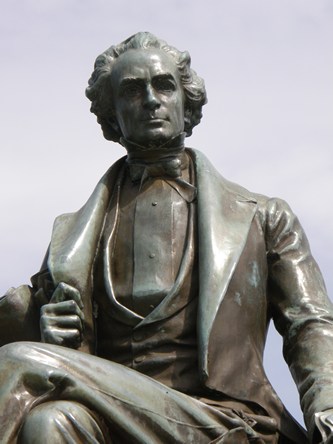|
|
The
gilded lettering on the cover is faded, and the green cloth binding
bears some staining, but my copy of a Congressional document with
the typically governmental title of “Proceedings of the House of Representatives
on the Occasion of the Reception and Acceptance from the State of
Texas of the Statues of Sam
Houston and Stephen
F. Austin – February 25, 1905” is still quite readable after more
than a century.
Forty years prior to the document’s publication, on July 2, 1864,
Congress passed an act to turn the original House chamber into a hall
of statuary, with each state able to contribute only two statues,
the same number of senators it can have. To be made of either marble
or bronze, the statues were to honor figures “illustrious for their
historic renown or from distinguished civic or military services…”
As of early 1905, only 20 states had furnished statues for the hall.
Today, all 50 states have their statues in place.
The 143-page House document includes the arcane legislation authorizing
acceptance of the two Texas statues, plus official copies of all the
Congressional oratory connected to their unveiling. Those speeches,
while flowery, included a history of Texas and the biographies of
the men being honored.
In fact, the volume stood as one of the better sources for information
on Austin’s
life until the publication in 1925 of Dr. Eugene C. Barker’s biography,
“The Life of Stephen F. Austin.”
While
its value as a reference has been considerably lessened over the year,
the Congressional document’s title is revealing of a long-standing
inequity that still stands today: Ole Sam gets more attention than
Austin, the man Houston himself called “the Father of Texas.”
By all measures of logic and grammatical correctness, the document’s
title should list Austin first and Houston second. For one thing,
“A” obviously comes before “H.” For another, Austin came to Texas
more than a decade before Houston, establishing an Anglo colony in
1821.
Of course, Houston always got more and better press than Austin. One
reason is that Houston lived longer (he died at 70 in 1863, Austin
at 43 in 1837). Too, Austin did not win the decisive battle
at San Jacinto that assured Texas’
independence from Mexico or have as colorful and controversial a life.
Finally, Houston was a much more colorful character than Austin.
Still, it would be hard to argue against the notion that had it not
been for Austin, Houston would not have won immortality – at least
not in Texas.
The elected speech makers taking part in the 1905 statue dedication
understood this.
“Stephen F. Austin and Sam Houston!” gushed Rep. Samuel Bronson Cooper
of Beaumont.
“The founder and the preserver! Each the complement of the other.
Without [an] Austin to build States no Houston would be needed to
liberate them from oppression or to defend them from aggression; and
without the sheltering and conserving genius of a Houston, vain would
be the work of those who lay the foundations of States amid the solitude
and savagery of the desert.”
Another speaker, Rep. Oscar W. Gillespie of Fort
Worth, put it this way:
“Austin’s life embodies hope; Houston’s, courage.”
The two statues dedicated that winter day in Washington were copies
of the statues sculpted by Texas artist Elisabet
Ney that had been placed in the Texas state house in 1903. |
 |
Texas
had been much slower to recognize Austin than Houston. Not until 1910
did Texas lawmakers finally decide Austin’s grave deserved to be in
the state
cemetery in Austin rather
than at Peach Point Plantation in Brazoria
County.
With family members and state officials on hand, Austin’s grave was
opened on Oct. 18, 1910 and his well-preserved bones exhumed and brought
by train to the Capital City
for reburial.
A military escort first bore the remains to the Capitol, where they
lay in state until being moved the following day to their final resting
place at the highest point of the state’s
burial ground.
The monument
over Austin’s new grave notes he was born Nov. 3, 1793. Texas
honors Jefferson Davis’ birthday, Lyndon B. Johnson’s birthday and
Caesar Chavez’, but not the day Austin started life.
On the other hand, Houston has his holiday, even if it does not formally
commemorate his birthday – Texas Independence Day. He was born March
2, 1793. Forty-three years later, at Washington-on-the-Brazos,
Texas declared its independence from Mexico. The legislature made
March 2 a holiday observed each year with a parade and various ceremonies. |
 |
| Stephen
F. Austin statue. TE Photo |
Despite the lack
of a Stephen F. Austin Day, the empresario has his giant-sized statue
near Angleton.
Earlier, a towering statue of Houston went up at Huntsville.
More recently, on Oct. 28, the Tarrant County Commissioners Court
in Fort Worth proclaimed
Nov. 3 as Stephen F. Austin Day in that county. When the Legislature
convenes in Austin in January,
maybe it’s time for Texas lawmakers to finally designate Nov. 3 as
a state holiday honoring Austin.
Even if the legislature continues to ignore Austin’s birthday, as
one of the 1905 speech makers noted, “geographical monuments” are
more enduring than marble or granite, brass or bronze, oil on canvas.
“So long as the counties of Houston and Austin are on the map,” declared
Rep. James Beauchamp Clark of Missouri, “so long as the ambitious
cities of Houston and Austin lift their spires to heaven, the names
of those twain will linger upon the tongues of men.”
© Mike Cox
"Texas Tales"
November 6, 2008 column |
|
|